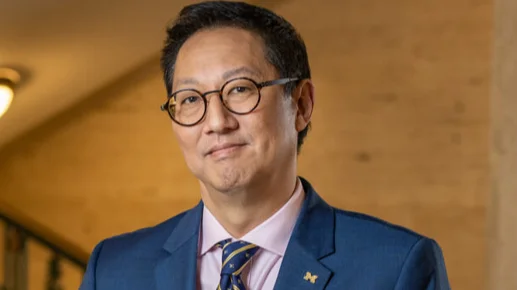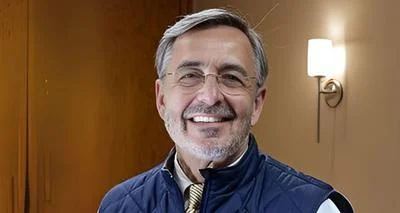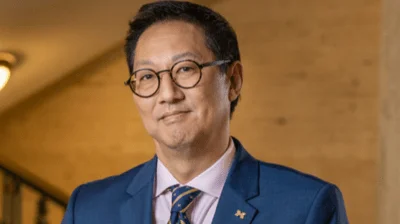Santa J. Ono, Ph.D. President at University of Michigan - Ann Arbor | Official website
Santa J. Ono, Ph.D. President at University of Michigan - Ann Arbor | Official website
Fifth and sixth grade students from Durand Middle School in Durand, Michigan, and The School at Marygrove in Detroit recently participated in the Pop-Up Safety Town Initiative at Mcity, the University of Michigan’s 30-acre urban mobility research facility. The event was a collaboration between Mcity and Pop-Up Safety Town, co-founded by University of Michigan physician Andrew Hashikawa. It aimed to provide hands-on traffic safety and STEM education for students from underserved communities.
This marks the first time that middle schoolers from both rural and urban districts attended the program at Mcity. According to Hashikawa, “We have never collaborated with this age group, this middle school population. So I think it is a unique opportunity on multiple fronts to leverage an amazing facility and bring together experts to teach kids about safety for a group we haven’t worked with in the past.
“(Mcity) is such an amazing facility. Where do you get real roads and walkways? It’s just a beautiful place to be able to do this.”
Hashikawa noted that more than half of the participating students had never visited the University of Michigan campus or any college campus before. He said, “I want them to realize the potential and come to U-M, and say, ‘Wow, you know, this exists down the road.'”
During their visit, students rotated through interactive stations designed to make learning practical. Each student received a fitted helmet as part of efforts to promote injury prevention and increase accessibility. Hashikawa explained that many families struggle with basic necessities like food, making helmets unaffordable for some: “When we looked at their surveys (from previous years), about 50% said that we don’t have helmets and we can’t afford them. When you are struggling with food and some of the basic necessities, a helmet doesn’t rise to the top.” Providing free helmets helps ensure that students can make safer choices outside of school.
University of Michigan students led activities throughout the day. Aidan Shoresh from Tau Beta Pi facilitated crash-test car-building exercises: “It’s really important because with the prevalence of online education, it’s important to have hands-on experiences,” Shoresh said. “For students to get involved, I think it’s really cool that they get to see in person—using their hands and building something that they can actually touch.
“From the engineering side, I think it’s meaningful for us college students to be involved in education just to make sure we are able to convey our ideas—for the human aspect.”
Students also practiced safe street crossing while riding nonmotorized scooters through simulated intersections at Mcity under guidance from medical student Dylan Hogan and undergraduates Ava Rawley and Saketh Addanki.
Teachers who attended emphasized how these activities connect classroom lessons with real-world applications. Angie Jewell from Durand Middle School said: “Hands on is a big deal. Being able to ride on the scooters with a helmet, that was awesome. Being able to construct the bridge with the materials given and that was all they could use, it was really neat to watch the kids work creatively.”
Laura Bollinger highlighted how making mistakes in a controlled environment helps reinforce safety lessons: “It’s safe to say I don’t have to worry about them having a vehicle involved or other agents involved that could cause detrimental consequences where if they can make these mistakes here and be like, OK, this could have been really bad if this were on a real roadway.”
Pier-La’Shaye Walker from Marygrove noted how rare such opportunities are for her students: “They would never have been able to do this anywhere else,” she said.
Rebecca Shankster, principal at Durand Middle School described watching her students navigate Mcity as an important experience: “It has been an amazing experience watching them navigate the streets here. They have been able to take the scooters around through the city and learn how to safely navigate roads, intersections and crossings,” she said. “We are very grateful for this opportunity for our students, a lot of whom have never been on a college campus before. They wouldn’t have this type of opportunity otherwise.”
Jewell added that she plans on referencing these lessons when teaching modern technology topics back in class.
Walker spoke about inspiring children through exposure: “This is their first opportunity and I would really like it if they did more of this... That really made me want to go to college.”
As participants completed their day at Mcity—taking home new skills along with helmets—the Pop-Up Safety Town Initiative demonstrated how educational programs can blend STEM learning with practical safety knowledge for young people across Michigan.
Hashikawa concluded by emphasizing broader impacts: The program gives children practical experience in injury prevention science while highlighting partnerships aimed at improving child safety statewide.






 Alerts Sign-up
Alerts Sign-up